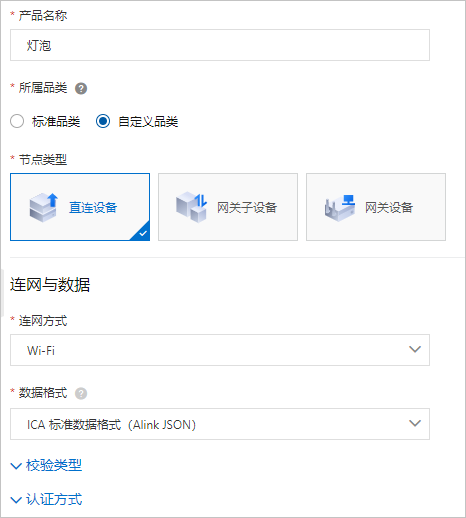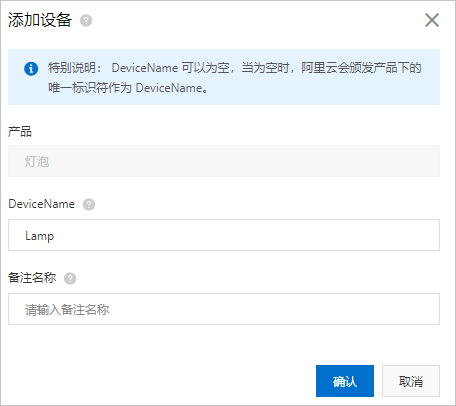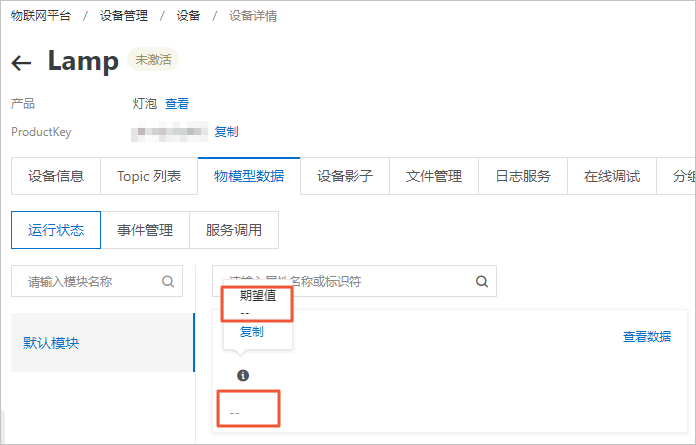物联网平台提供设置期望属性值功能,通过缓存设备属性的期望值,实现从物联网平台云端控制设备属性值。本文介绍设置期望属性值,实现从物联网平台控制灯泡状态的相关操作。
背景信息
灯泡设备接入物联网平台后,若需从物联网平台控制灯泡工作状态(1:打开;0:关闭),需要灯泡一直保持连网在线。实际情况下,灯泡可能无法一直在线。
您可在物联网平台设置设备期望属性值,使其存储在物联网平台云端。设备在线后,可读取物联网平台存储的期望属性值,来更新自身属性值。然后,设备会将更新后的属性值上报至物联网平台,在物联网平台的设备运行状态中显示。
创建产品和设备
在云端设置和查询期望属性值
您可在通过调用物联网平台云端API,设置和获取设备最新期望属性值。
具体操作,请参见云端API。本文以Java SDK(云端)为例。
- 调用SetDeviceDesiredProperty,设置期望属性值。
DefaultProfile profile = DefaultProfile.getProfile( "<RegionId>", // 地域ID "<accessKey>", //阿里云账号的AccessKey ID "<accessSecret>"); 阿里云账号AccessKey Secret IAcsClient client = new DefaultAcsClient(profile); // 创建API请求并设置参数 SetDeviceDesiredPropertyRequest request = new SetDeviceDesiredPropertyRequest(); request.setIotInstanceId("iot-060***"); request.setDeviceName("Lamp"); request.setProductKey("g4r***"); // 待设置的属性identifier与期望属性值 request.setItems("{\"LightStatus\": 1}"); request.setVersions("{\"LightStatus\": 0}"); // 发起请求并处理应答或异常 try { SetDeviceDesiredPropertyResponse response = client.getAcsResponse(request); System.out.println(new Gson().toJson(response)); } catch (ServerException e) { e.printStackTrace(); } catch (ClientException e) { System.out.println("ErrCode:" + e.getErrCode()); System.out.println("ErrMsg:" + e.getErrMsg()); System.out.println("RequestId:" + e.getRequestId()); } - 调用QueryDeviceDesiredProperty,查看设备的期望属性值。
DefaultProfile profile = DefaultProfile.getProfile( "<RegionId>", // 地域ID "<accessKey>", /阿里云账号的AccessKey ID "<accessSecret>"); 阿里云账号Access Key Secret IAcsClient client = new DefaultAcsClient(profile); // 创建API请求并设置参数 QueryDeviceDesiredPropertyRequest request = new QueryDeviceDesiredPropertyRequest(); request.setIotInstanceId("iot-06****"); request.setProductKey("g4r****"); request.setDeviceName("Lamp"); // 待查询的属性identifier列表。如不指定则查询所有属性(只读属性除外)的期望属性值。 List<String> identifierList = new ArrayList<String>(); identifierList.add("LightStatus"); request.setIdentifiers(identifierList); // 发起请求并处理应答或异常 try { QueryDeviceDesiredPropertyResponse response = client.getAcsResponse(request); System.out.println(new Gson().toJson(response)); } catch (ServerException e) { e.printStackTrace(); } catch (ClientException e) { System.out.println("ErrCode:" + e.getErrCode()); System.out.println("ErrMsg:" + e.getErrMsg()); System.out.println("RequestId:" + e.getRequestId()); }
有关如何设置代码中参数,请参见Java SDK使用说明。
在物联网平台云端设置设备期望属性值后,设备运行状态显示该值。

设备端开发
设备获取期望属性值,有两种场景:
- 灯泡重新上线时,主动获取物联网平台云端缓存的期望属性值。
- 灯泡正处于上线状态,实时接收物联网平台云端推送的期望属性值。
设备端开发更多信息,请参见使用设备端SDK接入。
本文以Java SDK为例,提供了完整的设备端Demo示例,请参见下文附录:设备端Demo代码。
- 填入设备证书、地域和MQTT接入地址的信息。
/** * 设备证书信息 */ private static String productKey = "******"; private static String deviceName = "********"; private static String deviceSecret = "**************"; /** * MQTT连接信息 */ private static String regionId = "******"; ...... /** * 设置 Mqtt 初始化参数 */ config.channelHost = deviceInfo.productKey + ".iot-as-mqtt." + region + ".aliyuncs.com:1883";说明- 设备证书信息,请参见本文上方创建产品和设备。
- regionId 为您的服务所在地域对应的Region ID。请在物联网平台控制台左上角,查看您服务所在的地域。Region ID表达方法,请参见支持的地域。
- channelHost 为MQTT接入地址。获取方法,请参见查看和配置实例终端节点信息(Endpoint)。
- 添加以下方法,用于变更实际灯泡的属性,并在属性变更后,主动将信息上报到最新属性值中。
/** * 真实设备处理属性变更时,在以下两个场下会被调用: * 场景1. 设备联网后主动获取最新的属性期望值(由设备发起,拉模式) * 场景2. 设备在线时接收到云端property.set推送的属性期望值(由云端发起,推模式) * @param identifier 属性标识符 * @param value 期望属性值 * @param needReport 是否通过property.post发送状态上报。 * 上面场景2的处理函数中已集成属性上报能力,会将needReport设置为false * @return */ private boolean handlePropertySet(String identifier, ValueWrapper value, boolean needReport) { ALog.d(TAG, "真实设备处理属性变更 = [" + identifier + "], value = [" + value + "]"); // 用户根据实际情况判性是否设置成功,这里测试直接返回成功 boolean success = true; if (needReport) { reportProperty(identifier, value); } return success; } private void reportProperty(String identifier, ValueWrapper value){ if (StringUtils.isEmptyString(identifier) || value == null) { return; } ALog.d(TAG, "上报属性identity=" + identifier); Map<String, ValueWrapper> reportData = new HashMap<>(); reportData.put(identifier, value); LinkKit.getInstance().getDeviceThing().thingPropertyPost(reportData, new IPublishResourceListener() { public void onSuccess(String s, Object o) { // 属性上报成功 ALog.d(TAG, "上报成功 onSuccess() called with: s = [" + s + "], o = [" + o + "]"); } public void onError(String s, AError aError) { // 属性上报失败 ALog.d(TAG, "上报失败onError() called with: s = [" + s + "], aError = [" + JSON.toJSONString(aError) + "]"); } }); } - 灯泡在线时,如果物联网平台设置了灯泡的期望属性值,该值将被推送到设备端。灯泡处理消息,改变属性状态。
如下代码中,将调用
connectNotifyListener处理消息,相关Alink协议说明,请参见设备上报属性。收到异步下行的数据后,
mCommonHandler被调用,进而调用handlePropertySet更新设备的物理属性。/** * 注册服务调用(以及属性设置)的响应函数。 * 云端调用设备的某项服务的时候,设备端需要响应该服务并回复。 */ public void connectNotifyListener() { List<Service> serviceList = LinkKit.getInstance().getDeviceThing().getServices(); for (int i = 0; serviceList != null && i < serviceList.size(); i++) { Service service = serviceList.get(i); LinkKit.getInstance().getDeviceThing().setServiceHandler(service.getIdentifier(), mCommonHandler); } } private ITResRequestHandler mCommonHandler = new ITResRequestHandler() { public void onProcess(String serviceIdentifier, Object result, ITResResponseCallback itResResponseCallback) { ALog.d(TAG, "onProcess() called with: s = [" + serviceIdentifier + "]," + " o = [" + result + "], itResResponseCallback = [" + itResResponseCallback + "]"); ALog.d(TAG, "收到云端异步服务调用 " + serviceIdentifier); try { if (SERVICE_SET.equals(serviceIdentifier)) { Map<String, ValueWrapper> data = (Map<String, ValueWrapper>)((InputParams)result).getData(); ALog.d(TAG, "收到异步下行数据 " + data); // 设置真实设备的属性,然后上报设置完成的属性值 boolean isSetPropertySuccess = handlePropertySet("LightStatus", data.get("LightStatus"), false); if (isSetPropertySuccess) { if (result instanceof InputParams) { // 响应云端,接收数据成功 itResResponseCallback.onComplete(serviceIdentifier, null, null); } else { itResResponseCallback.onComplete(serviceIdentifier, null, null); } } else { AError error = new AError(); error.setCode(100); error.setMsg("setPropertyFailed."); itResResponseCallback.onComplete(serviceIdentifier, new ErrorInfo(error), null); } } else if (SERVICE_GET.equals(serviceIdentifier)) { } else { // 根据不同的服务做不同的处理,跟具体的服务有关系 ALog.d(TAG, "根据真实的服务返回服务的值,请参照set示例"); OutputParams outputParams = new OutputParams(); // outputParams.put("op", new ValueWrapper.IntValueWrapper(20)); itResResponseCallback.onComplete(serviceIdentifier, null, outputParams); } } catch (Exception e) { e.printStackTrace(); ALog.d(TAG, "云端返回数据格式异常"); } } public void onSuccess(Object o, OutputParams outputParams) { ALog.d(TAG, "onSuccess() called with: o = [" + o + "], outputParams = [" + outputParams + "]"); ALog.d(TAG, "注册服务成功"); } public void onFail(Object o, ErrorInfo errorInfo) { ALog.d(TAG, "onFail() called with: o = [" + o + "], errorInfo = [" + errorInfo + "]"); ALog.d(TAG, "注册服务失败"); } }; - 灯泡离线后,如果物联网平台云端设置了灯的期望属性值,该值将被存储在云端。
灯泡上线后,会主动获取期望属性值,然后调用
handlePropertySet更新实际设备的属性。LinkKit.getInstance().init(params, new ILinkKitConnectListener() { public void onError(AError aError) { ALog.e(TAG, "Init Error error=" + aError); } public void onInitDone(InitResult initResult) { ALog.i(TAG, "onInitDone result=" + initResult); connectNotifyListener(); // 获取云端最新期望属性值 getDesiredProperty(deviceInfo, Arrays.asList("LightStatus"), new IConnectSendListener() { public void onResponse(ARequest aRequest, AResponse aResponse) { if(aRequest instanceof MqttPublishRequest && aResponse.data != null) { JSONObject jsonObject = JSONObject.parseObject(aResponse.data.toString()); ALog.i(TAG, "onResponse result=" + jsonObject); JSONObject dataObj = jsonObject.getJSONObject("data"); if (dataObj != null) { if (dataObj.getJSONObject("LightStatus") == null) { // 未设置期望值 } else { Integer value = dataObj.getJSONObject("LightStatus").getInteger("value"); handlePropertySet("LightStatus", new ValueWrapper.IntValueWrapper(value), true); } } } } public void onFailure(ARequest aRequest, AError aError) { ALog.d(TAG, "onFailure() called with: aRequest = [" + aRequest + "], aError = [" + aError + "]"); } }); } }); private void getDesiredProperty(BaseInfo info, List<String> properties, IConnectSendListener listener) { ALog.d(TAG, "getDesiredProperty() called with: info = [" + info + "], listener = [" + listener + "]"); if(info != null && !StringUtils.isEmptyString(info.productKey) && !StringUtils.isEmptyString(info.deviceName)) { MqttPublishRequest request = new MqttPublishRequest(); request.topic = DESIRED_PROPERTY_GET.replace("{productKey}", info.productKey).replace("{deviceName}", info.deviceName); request.replyTopic = DESIRED_PROPERTY_GET_REPLY.replace("{productKey}", info.productKey).replace("{deviceName}", info.deviceName); request.isRPC = true; RequestModel<List<String>> model = new RequestModel<>(); model.id = String.valueOf(IDGeneraterUtils.getId()); model.method = METHOD_GET_DESIRED_PROPERTY; model.params = properties; model.version = "1.0"; request.payloadObj = model.toString(); ALog.d(TAG, "getDesiredProperty: payloadObj=" + request.payloadObj); ConnectSDK.getInstance().send(request, listener); } else { ALog.w(TAG, "getDesiredProperty failed, baseInfo Empty."); if(listener != null) { AError error = new AError(); error.setMsg("BaseInfoEmpty."); listener.onFailure(null, error); } } }
验证结果
根据以下场景运行代码,验证灯泡在线、离线状态,可在物联网平台云端通过设置期望属性值,成功更改设备属性值。
- 设备在线时,云端修改灯泡开关状态,灯泡实时响应状态变化。
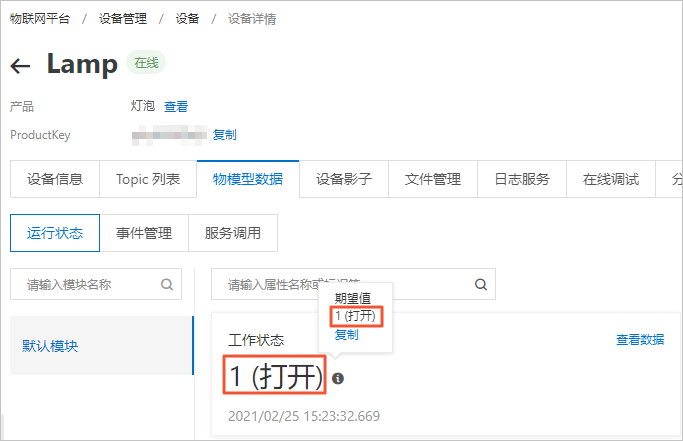
- 设备离线后,如果云端修改灯泡开关状态,云端期望属性值与设备的最新属性值不一致。

- 设备重新连网上线后,设备主动拉取期望属性值,设备的最新属性值实现与云端期望属性值的同步。
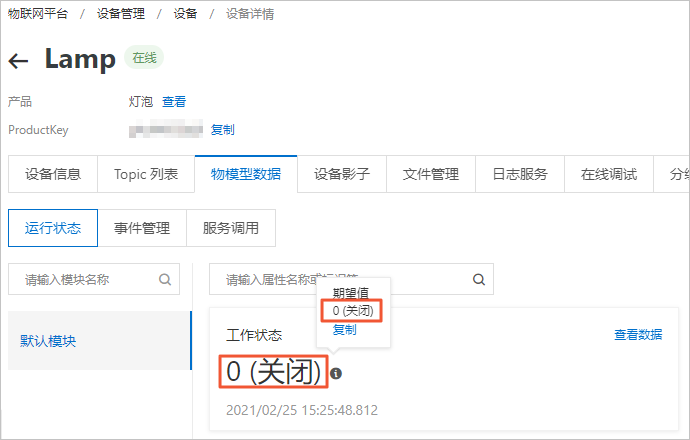
附录:设备端Demo代码
package com.aliyun.alink.devicesdk.demo;
import com.alibaba.fastjson.JSON;
import com.alibaba.fastjson.JSONObject;
import com.aliyun.alink.apiclient.utils.StringUtils;
import com.aliyun.alink.dm.api.BaseInfo;
import com.aliyun.alink.dm.api.DeviceInfo;
import com.aliyun.alink.dm.api.InitResult;
import com.aliyun.alink.dm.model.RequestModel;
import com.aliyun.alink.dm.utils.IDGeneraterUtils;
import com.aliyun.alink.linkkit.api.ILinkKitConnectListener;
import com.aliyun.alink.linkkit.api.IoTMqttClientConfig;
import com.aliyun.alink.linkkit.api.LinkKit;
import com.aliyun.alink.linkkit.api.LinkKitInitParams;
import com.aliyun.alink.linksdk.cmp.api.ConnectSDK;
import com.aliyun.alink.linksdk.cmp.connect.channel.MqttPublishRequest;
import com.aliyun.alink.linksdk.cmp.core.base.ARequest;
import com.aliyun.alink.linksdk.cmp.core.base.AResponse;
import com.aliyun.alink.linksdk.cmp.core.listener.IConnectSendListener;
import com.aliyun.alink.linksdk.tmp.api.InputParams;
import com.aliyun.alink.linksdk.tmp.api.OutputParams;
import com.aliyun.alink.linksdk.tmp.device.payload.ValueWrapper;
import com.aliyun.alink.linksdk.tmp.devicemodel.Service;
import com.aliyun.alink.linksdk.tmp.listener.IPublishResourceListener;
import com.aliyun.alink.linksdk.tmp.listener.ITResRequestHandler;
import com.aliyun.alink.linksdk.tmp.listener.ITResResponseCallback;
import com.aliyun.alink.linksdk.tmp.utils.ErrorInfo;
import com.aliyun.alink.linksdk.tools.AError;
import com.aliyun.alink.linksdk.tools.ALog;
import java.util.Arrays;
import java.util.HashMap;
import java.util.List;
import java.util.Map;
public class LampDemo {
private static final String TAG = "LampDemo";
private final static String SERVICE_SET = "set";
private final static String SERVICE_GET = "get";
public static String DESIRED_PROPERTY_GET = "/sys/${productKey}/${deviceName}/thing/property/desired/get";
public static String DESIRED_PROPERTY_GET_REPLY = "/sys/${productKey}/${deviceName}/thing/property/desired/get_reply";
public static String METHOD_GET_DESIRED_PROPERTY = "thing.property.desired.get";
public static void main(String[] args) {
/**
* 设备证书信息
*/
String productKey = "****";
String deviceName = "Lamp";
String deviceSecret = "****";
/**
* mqtt连接信息
*/
String regionId = "cn-shanghai";
LampDemo manager = new LampDemo();
DeviceInfo deviceInfo = new DeviceInfo();
deviceInfo.productKey = productKey;
deviceInfo.deviceName = deviceName;
deviceInfo.deviceSecret = deviceSecret;
manager.init(deviceInfo, regionId);
}
public void init(final DeviceInfo deviceInfo, String region) {
LinkKitInitParams params = new LinkKitInitParams();
/**
* 设置 Mqtt 初始化参数
*/
IoTMqttClientConfig config = new IoTMqttClientConfig();
config.productKey = deviceInfo.productKey;
config.deviceName = deviceInfo.deviceName;
config.deviceSecret = deviceInfo.deviceSecret;
config.channelHost = deviceInfo.productKey + ".iot-as-mqtt." + region + ".aliyuncs.com:1883";
/**
* 是否接受离线消息
* 对应 mqtt 的 cleanSession 字段
*/
config.receiveOfflineMsg = false;
params.mqttClientConfig = config;
/**
* 设置初始化,传入设备证书信息
*/
params.deviceInfo = deviceInfo;
LinkKit.getInstance().init(params, new ILinkKitConnectListener() {
public void onError(AError aError) {
ALog.e(TAG, "Init Error error=" + aError);
}
public void onInitDone(InitResult initResult) {
ALog.i(TAG, "onInitDone result=" + initResult);
connectNotifyListener();
// 获取云端最新期望属性值
getDesiredProperty(deviceInfo, Arrays.asList("LightStatus"), new IConnectSendListener() {
public void onResponse(ARequest aRequest, AResponse aResponse) {
if(aRequest instanceof MqttPublishRequest && aResponse.data != null) {
JSONObject jsonObject = JSONObject.parseObject(aResponse.data.toString());
ALog.i(TAG, "onResponse result=" + jsonObject);
JSONObject dataObj = jsonObject.getJSONObject("data");
if (dataObj != null) {
if (dataObj.getJSONObject("LightStatus") == null) {
// 未设置期望值
} else {
Integer value = dataObj.getJSONObject("LightStatus").getInteger("value");
handlePropertySet("LightStatus", new ValueWrapper.IntValueWrapper(value), true);
}
}
}
}
public void onFailure(ARequest aRequest, AError aError) {
ALog.d(TAG, "onFailure() called with: aRequest = [" + aRequest + "], aError = [" + aError + "]");
}
});
}
});
}
/**
* 真实设备处理属性变更,两个场景下会被调用:
* 场景1. 设备联网后主动获取最新的属性期望值(由设备发起,拉模式)
* 场景2. 设备在线时接收到云端property.set推送(由云端发起,推模式)
* @param identifier 属性标识符
* @param value 期望属性值
* @param needReport 是否发送property.post状态上报。
* 上面场景2的处理函数中已集成属性上报能力,会将needReport设置为false
* @return
*/
private boolean handlePropertySet(String identifier, ValueWrapper value, boolean needReport) {
ALog.d(TAG, "真实设备处理属性变更 = [" + identifier + "], value = [" + value + "]");
// 用户根据实际情况判断属性是否设置成功,这里测试直接返回成功
boolean success = true;
if (needReport) {
reportProperty(identifier, value);
}
return success;
}
private void reportProperty(String identifier, ValueWrapper value){
if (StringUtils.isEmptyString(identifier) || value == null) {
return;
}
ALog.d(TAG, "上报属性identity=" + identifier);
Map<String, ValueWrapper> reportData = new HashMap<>();
reportData.put(identifier, value);
LinkKit.getInstance().getDeviceThing().thingPropertyPost(reportData, new IPublishResourceListener() {
public void onSuccess(String s, Object o) {
// 属性上报成功
ALog.d(TAG, "上报成功 onSuccess() called with: s = [" + s + "], o = [" + o + "]");
}
public void onError(String s, AError aError) {
// 属性上报失败
ALog.d(TAG, "上报失败onError() called with: s = [" + s + "], aError = [" + JSON.toJSONString(aError) + "]");
}
});
}
/**
* 注册服务调用(以及属性设置)的响应函数。
* 云端调用设备的某项服务的时候,设备端需要响应该服务并回复。
*/
public void connectNotifyListener() {
List<Service> serviceList = LinkKit.getInstance().getDeviceThing().getServices();
for (int i = 0; serviceList != null && i < serviceList.size(); i++) {
Service service = serviceList.get(i);
LinkKit.getInstance().getDeviceThing().setServiceHandler(service.getIdentifier(), mCommonHandler);
}
}
private ITResRequestHandler mCommonHandler = new ITResRequestHandler() {
public void onProcess(String serviceIdentifier, Object result, ITResResponseCallback itResResponseCallback) {
ALog.d(TAG, "onProcess() called with: s = [" + serviceIdentifier + "]," +
" o = [" + result + "], itResResponseCallback = [" + itResResponseCallback + "]");
ALog.d(TAG, "收到云端异步服务调用 " + serviceIdentifier);
try {
if (SERVICE_SET.equals(serviceIdentifier)) {
Map<String, ValueWrapper> data = (Map<String, ValueWrapper>)((InputParams)result).getData();
ALog.d(TAG, "收到异步下行数据 " + data);
// 设置真实设备的属性,然后上报设置完成的属性值
boolean isSetPropertySuccess =
handlePropertySet("LightStatus", data.get("LightStatus"), false);
if (isSetPropertySuccess) {
if (result instanceof InputParams) {
// 响应云端,接收数据成功
itResResponseCallback.onComplete(serviceIdentifier, null, null);
} else {
itResResponseCallback.onComplete(serviceIdentifier, null, null);
}
} else {
AError error = new AError();
error.setCode(100);
error.setMsg("setPropertyFailed.");
itResResponseCallback.onComplete(serviceIdentifier, new ErrorInfo(error), null);
}
} else if (SERVICE_GET.equals(serviceIdentifier)) {
} else {
// 根据不同的服务做不同的处理,跟具体的服务有关系
ALog.d(TAG, "用户根据真实的服务返回服务的值,请参照set示例");
OutputParams outputParams = new OutputParams();
// outputParams.put("op", new ValueWrapper.IntValueWrapper(20));
itResResponseCallback.onComplete(serviceIdentifier, null, outputParams);
}
} catch (Exception e) {
e.printStackTrace();
ALog.d(TAG, "云端返回数据格式异常");
}
}
public void onSuccess(Object o, OutputParams outputParams) {
ALog.d(TAG, "onSuccess() called with: o = [" + o + "], outputParams = [" + outputParams + "]");
ALog.d(TAG, "注册服务成功");
}
public void onFail(Object o, ErrorInfo errorInfo) {
ALog.d(TAG, "onFail() called with: o = [" + o + "], errorInfo = [" + errorInfo + "]");
ALog.d(TAG, "注册服务失败");
}
};
private void getDesiredProperty(BaseInfo info, List<String> properties, IConnectSendListener listener) {
ALog.d(TAG, "getDesiredProperty() called with: info = [" + info + "], listener = [" + listener + "]");
if(info != null && !StringUtils.isEmptyString(info.productKey) && !StringUtils.isEmptyString(info.deviceName)) {
MqttPublishRequest request = new MqttPublishRequest();
request.topic = DESIRED_PROPERTY_GET.replace("{productKey}", info.productKey).replace("{deviceName}", info.deviceName);
request.replyTopic = DESIRED_PROPERTY_GET_REPLY.replace("{productKey}", info.productKey).replace("{deviceName}", info.deviceName);
request.isRPC = true;
RequestModel<List<String>> model = new RequestModel<>();
model.id = String.valueOf(IDGeneraterUtils.getId());
model.method = METHOD_GET_DESIRED_PROPERTY;
model.params = properties;
model.version = "1.0";
request.payloadObj = model.toString();
ALog.d(TAG, "getDesiredProperty: payloadObj=" + request.payloadObj);
ConnectSDK.getInstance().send(request, listener);
} else {
ALog.w(TAG, "getDesiredProperty failed, baseInfo Empty.");
if(listener != null) {
AError error = new AError();
error.setMsg("BaseInfoEmpty.");
listener.onFailure(null, error);
}
}
}
}该文章对您有帮助吗?

